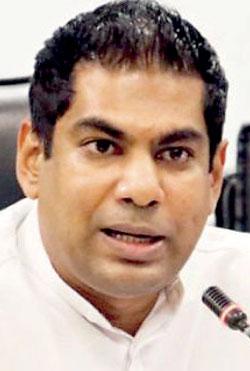Reply To:
Name - Reply Comment
 A few weeks ago, the Ceylon Electricity Board (CEB) posted a ‘wanted’ advertisement for a Financial Consultant ‘to provide guidance on investment decisions, cash management and day-to-day organizational expenses
A few weeks ago, the Ceylon Electricity Board (CEB) posted a ‘wanted’ advertisement for a Financial Consultant ‘to provide guidance on investment decisions, cash management and day-to-day organizational expenses
On the face of it, this is a good move. In fact, all state-owned enterprises, statutory bodies, state institutions including ministries ought to be regularly monitored and evaluated, inefficiency and incompetence determined and action taken against those responsible if that be the case. The flip side — and we say this taking into consideration the history of such exercises — is to place an agent or set of agents in such positions with an informal but specific brief: deliver ‘findings’ that can justify policy directions already envisaged.
In any event, power and energy minister Kanchana Wijesekera has been saying a lot about cost-reflective pricing, amending legislation and restructuring. All good, except that we are yet to hear him talk specifics in relation to legislative enactment in relation to doing away with archaic clauses which in the name of energy security ensure continued dependence on dollar draining imports.
 Sri Lanka, not too long ago, was ahead of India in terms of national coverage. India at the time was heavily dependent on coal and thermal energy. Power cuts were normal. In 2015 Premier Narendra Modi essentially told the Indian counterparts of CEB officials that India will go for solar power. They were required to fall in line or else. Today most of India’s state grids are completely self-sufficient and India is even exporting electricity to Bangladesh.
Sri Lanka, not too long ago, was ahead of India in terms of national coverage. India at the time was heavily dependent on coal and thermal energy. Power cuts were normal. In 2015 Premier Narendra Modi essentially told the Indian counterparts of CEB officials that India will go for solar power. They were required to fall in line or else. Today most of India’s state grids are completely self-sufficient and India is even exporting electricity to Bangladesh.
What’s Sri Lanka’s story? Given the relative total generating potential, scale, population and demand, Sri Lanka could have produced a surplus. Had the CEB got its act together, looked at global trends and technological development, Sri Lanka wouldn’t have ended up in this pathetic dollar-deficient, import-dependent situation. To put it bluntly, it’s a matter of monkey-sees, monkey does. No expertise, no vision, no compulsion; not since Wimalasurendra.

The CEB and Wijesekera must know, cannot be ignorant of the fact that Sri Lanka has tremendous renewable generation potential well in excess of even projected increase in local demand. Today countries such as Indonesia, Singapore and Malaysia are talking of importing solar based electrical energy from Australia via an undersea cable almost 2,800 km in length. Sri Lanka is just 1,800 km away from Bangladesh, a fact that can only become significant, if Sri Lanka aggressively pursues the eminently logical option of developing the renewable sector.
 The general rule of thumb for the CEB to meet peak demand is to depend on thermal energy. ‘Emergency power,’ when required all the time, makes the adjective meaningless. The CEB has no plan to reduce reliance on emergency power which translates in practical terms to that which a preferred supplier can deliver upon a quick call. Greasing of palms then? Kanchana’s Financial Consultant (FC), if appointed and if possessing any integrity, may find out.
The general rule of thumb for the CEB to meet peak demand is to depend on thermal energy. ‘Emergency power,’ when required all the time, makes the adjective meaningless. The CEB has no plan to reduce reliance on emergency power which translates in practical terms to that which a preferred supplier can deliver upon a quick call. Greasing of palms then? Kanchana’s Financial Consultant (FC), if appointed and if possessing any integrity, may find out.
The CEB, it is well known, fought hard to scuttle plans for enhancing the contribution of renewables which, theoretically could satisfy the entire demand for electricity and even double it for export. The CEB grudgingly agreed to a plan to bump the slice to 70% but this hasn’t moved from policy to implementation. Interestingly, no other country in the world has quibbled over numbers related to targets.
Engineers simply say ‘more expensive, it’s not worth it.’ And they point to archaic legislation related to unwarranted concern about energy security which, interestingly, goes against the economic model that successive governments have embraced for close to fifty years now, namely the limitation on installed capacity, 50MW. So, ‘Mega Solar’ is out of the question.
The CEB sites ‘inertia,’ as an inhibiting factor. In other words, thermal energy is constant whereas solar is dependent on factors that cannot be controlled, bad weather days, cloud cover etc. In consistency plugged into the grid could trigger it to trip, this is correct. However, the concern of instability is easily addressed and indeed has been addressed in countries with worse ‘inhibiting factor’ not just those that are developed but by countries in Latin America. Maybe the CEB is ignorant, lacks expertise or, worryingly, knows very well that such transformation could trip cutbacks.
Perhaps this is why the CEB seems to be so averse to digitizing the grid. The know-how and technology exist, however, to put in place a highly digitized oversight system based on predictive artificial intelligence on both the generation and demand side, capable of even a 15-minute dispatch. Instead, someone can make a call to a power generator, fiddle with numbers, scaremonger governments into submission and make a sweet deal with a supplier, thereby cutting into Sri Lanka’s exchange reserves.
Digitization would make things transparent. Accountable. Good for all except whoever is making bucks by blocking the move towards renewables. One wonders if Kanchana would ask his buddies in the World Bank and IMF to facilitate digitization? Would they say ‘no’? Unlikely.
The CEB has also talked of the problem posed by grid infrastructure or lack thereof, e.g., ‘we need to build more high-tension transmission lines.’ This is a barefaced lie. To put it crudely, no transformer on the planet will argue about the source. Doesn’t know, doesn’t care. As long as you feed the electricity to the specification the transformer is built to receive.
For example, if floating solar panels were installed in all the reservoirs currently producing hydropower, ensuring that less than 15% of the relevant surfaces are used in order not to infringe upon environments, the very same transformers could be used. The hydropower could be used as back up, again based on a system of AI-based generation governance that is transparent and accountable and greasing-free.
The truth is that we would not be needing any backup or ‘emergency power generation’ if we utilized the Negombo, Kalpitiya, Batticaloa, Trincomalee and Jaffna lagoons, all locations there are currently touched by transmission lines. No additional infrastructure expenditure, but enabling massive solar generation even at using just 15% of the surface so that there are no environmental concerns.
Back to numbers. The current peak demand is projected to double by 2030, requiring an additional 15,000 MW to be provided to the grid. As is, the lagoons and the Mahaweli reservoirs could generate 8,000 MW, meaning that at any given time there’s at least 4,000-4,500 MWs for export, provided of course that there is investment for installation of cables. If the full solar potential of just floating solar capacities is obtained, Sri Lanka could become a dominant net energy exporter in the region. CEB will never be a bankrupt institution, never be a dollar-demanding institute but actually a dollar-earning institute. Good, isn’t it?
If the story takes too much space, please cut the last 2 paras in blue.
Yes, there are costs. Floating solar panels don’t fall from the sky or drip along with sunbeams. If, say, the installation cost is US$1.5 million per MW, the total cost would be in the region of US$6 billion. Obviously, it should be opened to private investors. If Kanchana and this government is truly ok with that kind of economic policies, then, why not? We would not be needing a single dollar on imports to produce coal or thermal power. Bad idea? What would the FC say?
As of now, neither Kanchana nor anyone in the CEB seem interested. If no one is, it means that rank idiocy and corruption could be the main reasons. Or rank incompetence. The FC could tell us, of course. And maybe we will have meaningful change which of course requires the necessary restructuring of thinking-ways, frames of reference and of course overall, long-term objectives of energy security and insulation against dollar-dependency.
malindadocs@gmail.com. www.malindawords.blogspot.com
It is a body comprising companies such as Amazon, Apple, Booking.com, Expedia Group, Google, GoTo, Grab, LINE, LinkedIn, Meta, Rakuten, X and Yahoo.


